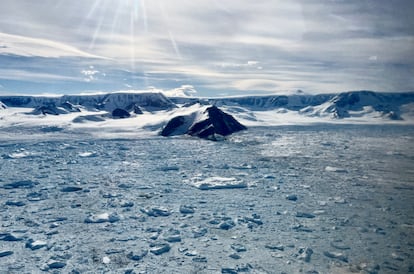The largest retreat of a glacier on land, more than eight kilometers in just two months: “It’s truly spectacular”

Researchers from the US, UK, Canada, and France have documented a record retreat of the Hektoria Glacier on the Antarctic Peninsula, measuring more than eight kilometers in just two months. The measurement is part of a study published this week in Nature Geoscience , which analyzes this astonishing loss of ice on land between November and December 2022, at a rate nearly 10 times faster than previously observed.
Land-supported glaciers in polar regions generally retreat no more than a few hundred meters per year, but in the case of Hektoria, scientists have calculated, through satellite and aerial images, as well as altimetric data on the ground, a loss of approximately 800 meters per day.
As Etienne Berthier, a glaciologist at the Laboratory of Studies in Geophysics and Space Oceanography at the University of Toulouse (France) and one of the authors of the study, explains, “Such strong and rapid retreats can be seen regularly in floating ice shelves, when the glacier ends with a tongue of ice over the sea, where the largest icebergs are formed, but what is so extraordinary here is that it has happened with the ice resting on the bedrock and more than eight kilometers in just two months for this type of glacier is truly spectacular.”

Unlike floating ice, when melting occurs on land and that water flows directly into the sea, it is also significant because it contributes to rising sea levels . Therefore, understanding how polar glaciers behave and what factors influence their rate of retreat is key to accurately predicting how high sea levels will rise on continental coastlines as a result of global warming.
According to Berthier, never before has a reduction of land ice of the magnitude seen in Hektoria been recorded by satellites, aircraft, or scientific observations on the ground. However, estimates of the rate of retreat of the ice sheet that covered Scandinavia 20,000 years ago have been made based on the morphological traces left by the ice, indicating that there were indeed periods of retreat of this magnitude in the past, of several hundred meters per day.

“This is the only analogy we know of in the past of such a rapid retreat, but it is important because it shows that in periods of very rapid warming, instabilities of the polar masses can occur with such extraordinary reductions for the ice resting on the bedrock,” comments the glaciologist from the University of Toulouse.
The researchers conclude that the astonishing rate of melting in this part of the Antarctic Peninsula is related to the physical characteristics of the surface where the Hektoria Glacier rests. Specifically, the terrain is particularly flat along the coast, meaning that even small variations in elevation can expose a large area of ice to the sea.
However, Berthier details how this entire process is also related to the 2002 disintegration of the gigantic ice shelf called Larsen B. That event, which occurred more than two decades ago, accelerated the melting of the glaciers that flowed into this floating platform, since the ice shelves above the sea act like a cork in a bottle , containing the meltwater coming from the land. “Ultimately, the entire evolution of this Antarctic region is linked to global warming ,” emphasizes the glaciologist, who believes that the collapse of Larsen B and the current record-breaking Hektoria Glacier are part of “a chain reaction” caused by rising temperatures.
Of the many impacts related to the melting of Earth's ice sheets, sea level rise is the one that most widely affects humanity. In this regard, after the warming of the oceans themselves (which increases their volume due to expansion), the other causes of rising sea levels are the melting of mountain glaciers and the melting of the Greenland and Antarctic ice sheets. Currently, each of these factors contributes roughly one-third.
EL PAÍS





